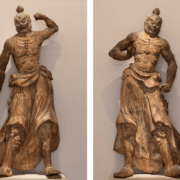The word orthodontics is as ancient as the practice itself. It comes from the Greek “ortho,” meaning straight, and “don’t,” meaning tooth. And even though we often think of braces as a modern invention, they’ve been around for over 3,000 years!
Curious about the fascinating history of orthodontics? Take a trip through time to learn how we evolved from gold and sheep intestines to 3D printed devices!
Ancient Empires, Ancient Orthodontics
The American Association of Orthodontists suggests that the first orthodontic evaluations should occur at age seven. But ancient Egyptian and Etruscan empires would disagree. They preferred to wait until death to get braces!
The afterlife was a prominent event for ancient cultures, and the deceased desired to look their best. Archeologists have discovered many Egyptian mummies wearing primitive forms of braces. These devices were created using catgut, a fiber made from animal intestines.
The catgut acted as a wire to close gaps between teeth and keep everything in place. The ancient Etruscans (predecessors to the Romans) practiced a similar tradition. They opted for gold bridges that resembled mouthguards to keep the deceased’s teeth looking glamorous.
The ancient Romans took these ideas and applied them to the living. Aulus Cornelius Celsus was an early Roman researcher who hypothesized that crooked teeth can be moved by force. He practiced applying pressure with his finger at regular intervals to misaligned teeth.
His notes reveal that the teeth did move to straighter positions eventually! This practice may have led to the first Roman dental device. A thin ligature wire made of gold was wound through the teeth to force alignment.
Not to be outdone, the ancient Greeks pondered the question of crooked teeth as well. The infamous Hippocrates shared the first official description of tooth irregularities in 400 B.C. The ancient Greeks likely used similar straightening methods as the Romans.
The 1700s: Advances in Research
The Middle Ages were a dark time for dentistry and orthodontics. Thankfully, by the late 1600s, orthodontics was a booming field of medicine. Pierre Fauchard is often called the father of modern dentistry for his invention of the bandeau.
Fauchard was a French dentist famous for his book The Surgeon Dentist. It outlined how to correct crooked teeth, fix misaligned jaws, and create perfect smiles. He began using the bandeau, a horseshoe-shaped device, to straighten the teeth of the upper class.
In the mid-1700s, another French dentist, Louis Bourdet, was inspired by Fauchard. As the King’s dentist, he had the crucial job of keeping the royalty beautiful. Bourdet became the first dentist to suggest removing teeth to prevent overcrowding issues.
Throughout this century, the evolution of orthodontics continued at full steam. Researchers developed tools and appliances to help the process advance. Dental literature also evolved to include terms like malocclusion for the first time.
The Original Braces of the 1800s
The 1800s was truly a time of orthodontic enlightenment. The first pair of braces resembling our modern version appeared in 1819. Christophe-Francois Delabarre was the brain behind this “wire crib.”
A few years later, J.S. Gunnel created a prototype of orthodontic headgear designed to fix protruding teeth. But things really picked up with the invention of rubber in the mid-1800s. E.J. Tucker elaborated on an earlier idea of using gum elastics to move teeth into position.
Tucker cut the newly invented rubber tubing into small bands. He used them to connect the metal wiring, creating a modern version of the braces. The technique allowed for teeth to steadily settle into alignment.
The very end of the century brought x-rays into the world of orthodontics. Eugene S. Talbot began using x-rays to find impacted teeth and remove them. This method would create more space in the mouth and eliminate overcrowding.
20th Century Orthodontics
By the 20th century, dentists had figured out the basic techniques of moving teeth. But safety, material, and practice standards did not yet exist. Dentists used ivory, copper, wood, zinc, silver, or gold to create braces.
The material type depended on the client’s budget and what was available in the geographical location. But gold was the preferred choice due to its flexibility. Bands, wires, and clasps were often made from gold if the patient could afford it.
The American Board of Orthodontics was formed in the 1930s. This event jumpstarted decades of research, innovation, and medical advances. But braces remained fairly primitive, involving a band wrapped around each tooth.
The process was long, laborious, and uncomfortable. Significant changes came in the 1970s when dentists began to use stainless steel, adhesive brackets, and elastics. The popularity of lingual braces also grew during the next few decades, paving the way for modern appliances.
Welcome to the Modern 90s
The 1990s gave us an explosion of technology! The internet, cell phones, and … Invisalign? This remarkable advancement in orthodontics was the brainchild of two Stanford graduates with zero dental knowledge. A plastic retainer was their inspiration to create clear trays that would shift teeth into position.
Zia Chishti and Kelsey Wirth called this process Invisalign, and it took the world by storm. Since then, Align technology has continued to evolve and improve. 3D printing, digital imaging, and cloud-based dental records have become as commonplace as laptops.
At the same time, traditional braces received a much-needed upgrade. A NASA-produced material, originally made in the 1960s, became available for dental use. This heat-activated nickel-titanium metal became the basic for archwires.
The new archwires could move teeth more efficiently and comfortably. This technology reduced the length of wear from four years to a year or two! Now, over four million individuals use braces to get perfect smiles at any given time.
The Fascinating History of Orthodontics
Braces have been around longer than most people think! From the Ancient Romans to 18th-century pioneers of braces, the history of orthodontics is riveting. Who knows what the next 3,000 years will bring?
Did you enjoy this behind-the-scenes look at history’s attempt to create perfect smiles? Then check out some more of our articles, guides, and tips!












Comments